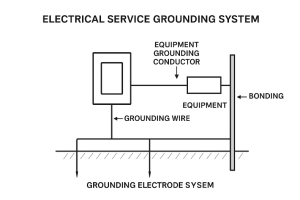 An Electrical Service Grounding System Design is the process of planning and implementing a safe, effective grounding and bonding system for an electrical power distribution network. Grounding is one of the most critical aspects of electrical system safety, as it provides a low-impedance path for fault currents, stabilizes system voltage, and protects people, equipment, and property.
An Electrical Service Grounding System Design is the process of planning and implementing a safe, effective grounding and bonding system for an electrical power distribution network. Grounding is one of the most critical aspects of electrical system safety, as it provides a low-impedance path for fault currents, stabilizes system voltage, and protects people, equipment, and property.
Purpose of Grounding System Design
The main objectives of grounding are to:
- Protect People from Electric Shock
- Ensures exposed conductive parts (like enclosures and panels) do not remain energized during faults.
- Provide a Path for Fault Currents
- Safely direct fault current to ground to trip protective devices like breakers or fuses.
- Stabilize Voltage During Transients
- Reduces voltage fluctuations caused by lightning, switching surges, or utility faults.
- Comply with Codes and Standards
- Must meet the requirements of NEC Article 250, IEEE 142 (Green Book), NFPA 70E, and UL standards.
- Prevent Equipment Damage
- Protects transformers, generators, motors, and sensitive electronics by preventing overvoltage conditions.
Key Components of a Grounding System
A properly designed electrical service grounding system typically includes the following:
- Grounding Electrode System
The physical connection between the electrical system and the earth.
Common grounding electrodes include:
- Ground rods (driven rods)
- Concrete-encased electrodes (Ufer ground)
- Metal water pipe (if permitted by NEC)
- Ground rings (wire buried around the building perimeter)
- Structural steel embedded in concrete
- System Grounding (Neutral Grounding)
Connecting one point of the electrical system—typically the neutral of a transformer or generator—to ground.
Types of system grounding:
- Solidly grounded – most common in commercial buildings.
- Resistance grounded – used in industrial settings to limit fault current.
- Ungrounded – rarely used, for specialized processes.
- Equipment Grounding Conductors (EGCs)
- Bond metal enclosures, raceways, and non-current-carrying conductive parts to the grounding system.
- Examples:
- Conduit
- Cable armor
- Panelboards
- Motor frames
- Bonding
- Bonding connects all metal parts and grounding components together to eliminate potential differences.
- This is critical for:
- Building steel
- Water piping
- Gas piping
- Communication systems
- Lightning protection systems
- Grounding Busbars
- Central points in electrical rooms where grounding conductors and bonds converge.
- Often used in data centers and large industrial plants.

